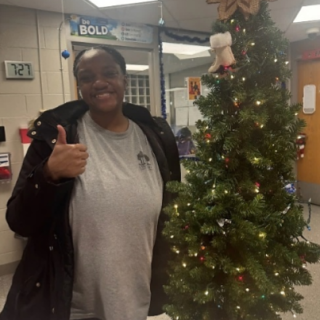Advertisement
A 14-year-old former gang member of the “MBKs” or “My Brother’s Keepers,” told his story to the Free Press. He was living in the Hilltop, but now no longer lives near Mound Street because he was taken away from his mother and placed into foster care after spending a year in “juvy” or juvenile detention center. This is his story, mostly unfiltered. It is unfortunately a longtime reality of certain Columbus neighborhoods.
To be clear, the 14-year-old’s hair is fluffy light brown, his skin is milky white. He looks more Hilliard than Hilltop, but life is far more nuanced than stereotypes.
“The MBKs is mixed,” he tells us. “I was jumped in,” he adds, referring to his initiation.
“I robbed people. Downtown, the Short North,” he says. The Free Press could not independently corroborate his entire story.
He twists his hand around an imaginary handgun barrel. “With the silencer. That’s how you rob trap houses. I shot some people.” A trap house is where addicts repeatedly go for their fix.
“My mom told me we needed money. We were broke, we were going to be put out,” he explains. “They [the MBKs] gave me a pound of cocaine and told me to go sell it. I made $2,000 and gave most of it to my mom. She didn’t ask where it came from.”
His future is seriously in doubt. Will the 14-year-old forsake gang life and return to school? Many will shake their heads because the latest drug epidemic refuses to release its teeth, and the allure of real money is too tempting for gang members who have easy access to legal guns which continue to flood into the community.
There are glimmers of hope on the Westside though, places where at-risk youth can turn for help if they so choose.
MY Project USA Youth Empowerment Center is one organization offering a way out. The unlikely hero behind its creation and leadership is Zerqa Abid or “Sister Zerqa,” who describes herself as an “activist all my life.”
She is diminutive in stature, but she has already proven to the Westside and to Sullivant Avenue that a woman can move mountains where most men have barely moved the needle.
MY Project USA is a national endeavor and recently moved its Sullivant Avenue headquarters of five years into a former grocery store further up the street. The new location is in many ways strategic, situated between the Hilltop and the Wedgewood Village apartment community where immigrant families and others have been coping with drug-dealing related violence for years.
The good news is, MY Project USA’s new digs – going through an extensive rehab – is far more visible to the community than the previous location.
“We needed a new place. It was too small and wasn’t working for us anymore. So I bought this property,” said Abid to the Free Press.
For five years Abid sought a new home for her brainchild, the Columbus Foundation and others have helped, and she received an Small Business Association loan for instance. The City has assisted financially with grants for programs but not with the purchase of the property.
“We are going forward with all of this expansion and renovation because we have asked for a space for the last five years. For five years we have been serving Wedgewood and saying, ‘We don’t have any space,’” she said. “We didn’t have a space where we could go to in the evening. This was a need. We borrowed loans and did whatever we needed to provide a safe space for our children.”
The new building will not be a drop-in for homeless youth who need overnight shelter, but “anyone who walks in the building we will try to help,” said Abid, who has also advocated for victims of sex trafficking and prostitution, a huge problem up and down Sullivant.
Abid also has success in tearing apart what seems unbreakable.
“From what I have heard, our programs have severed the pipeline that was fueling young people into gangs before. Our programs have made that disconnect,” she said. “Our young people are choosing to play soccer, choosing to come into our program.”
She believes there are several factors why 13-year-olds join gangs like the MBKs.
“But the most important factor is that there was nothing for them to do here in the neighborhood. There was no recreation, there was no programs. Their parents are working three jobs so they are left alone,” she said. “The children are easy prey for all these criminals out there. For drug dealers, who spend a few dollars on their meals or offering them something very low, and using them as drug mules is so easy.”
Wedgewood Village has become a target for those who relish to disparage areas of urban Columbus where drug-related violence brings too much attention from police. These cold-hearted critics scoff – there’s no way to save Wedgewood Village or the young people living there.
Abid refuses to believe this. Wedgewood and nearby neighborhoods can be saved, “one hundred percent,” she says.
“I’ve always said I want to make Wedgewood a model community where the police, the community and the administration can work together for the better. My Wedgewood kids are not as scared of police officers as they used to be five years ago,” she said. “There is a relationship, there is an understanding. The police officers who come into our neighborhood know our kids.”
Abid says her call to activism was inspired by her own motherhood.
“This center is for everyone,” she says.



